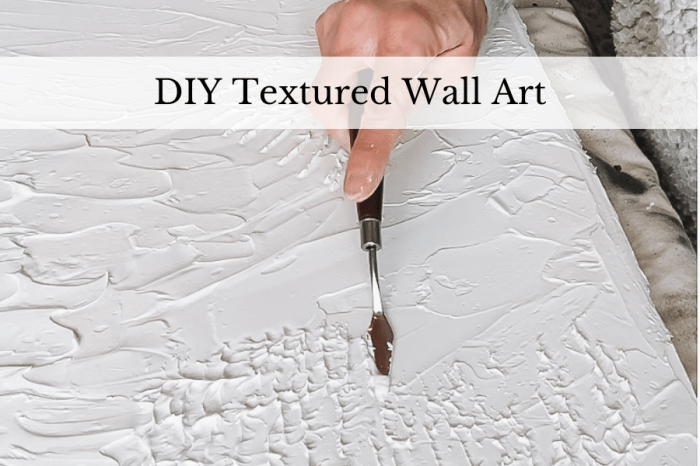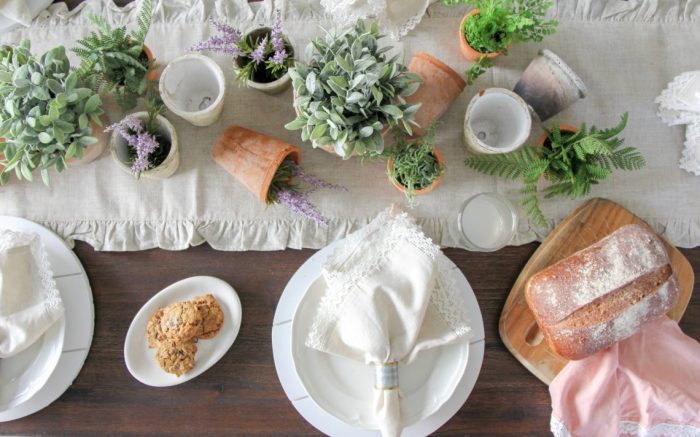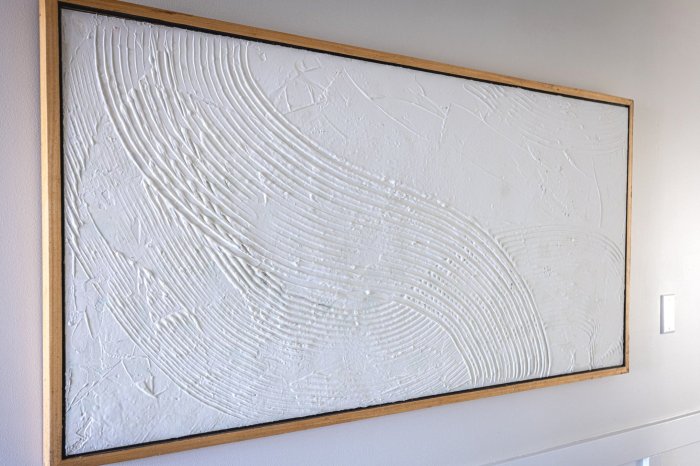DIY texture wall art offers a unique and engaging way to personalize your home, transforming ordinary walls into captivating focal points. This creative endeavor allows you to express your artistic vision and add a touch of individuality to any room. Whether you’re drawn to the rustic charm of textured plaster or the sleek sophistication of layered paint, DIY texture wall art provides endless possibilities for artistic expression.
From creating a dramatic accent wall to adding subtle depth to a neutral backdrop, texture can enhance the visual appeal of your space. The process of creating texture can be therapeutic, allowing you to experiment with different materials and techniques, while the final results can be truly rewarding. This guide will equip you with the knowledge and inspiration to embark on your own DIY texture wall art journey.
Introduction to DIY Texture Wall Art

DIY texture wall art is a creative and engaging way to add depth and dimension to your walls. It involves using various materials and techniques to create unique and personalized textures, transforming a plain wall into a captivating focal point. This form of art is accessible to everyone, regardless of artistic experience, allowing you to express your creativity and personal style.
Benefits of Creating DIY Texture Wall Art
Creating DIY texture wall art offers numerous benefits, both practical and aesthetic. It allows you to personalize your space, reflecting your individual taste and preferences. The process itself can be therapeutic and relaxing, providing a creative outlet for stress relief. Additionally, DIY texture wall art is a cost-effective way to enhance your home decor, allowing you to achieve a high-end look without breaking the bank.
Appeal and Popularity of DIY Texture Wall Art
DIY texture wall art has gained significant popularity due to its versatility and accessibility. The wide range of materials and techniques available allows for endless creative possibilities, enabling individuals to create unique and personalized pieces. The growing trend of DIY projects and home decor customization has also contributed to the popularity of DIY texture wall art, as people seek to create spaces that reflect their individual style and personality.
Materials and Tools
The materials you choose will determine the final look and feel of your texture wall art. A variety of tools are essential for creating different textures.
Materials
The following is a list of common materials used for DIY texture wall art.
- Paint: Paint is the base for most texture wall art. Acrylic paint is a popular choice due to its quick drying time and versatility. You can use a single color or mix and match to create unique effects.
- Texture Medium: Texture medium is a thick, paste-like substance that adds texture to paint. It comes in a variety of finishes, including sand, grit, and crackle. It can be mixed with paint or applied directly to the wall.
- Additives: Additives can be added to paint or texture medium to alter the texture or appearance of the final product. Common additives include sand, sawdust, plaster, and even coffee grounds.
- Stencils: Stencils can be used to create patterns and designs in your texture wall art. They are available in a wide variety of shapes and sizes, and can be made from materials like plastic, metal, or even cardboard.
- Sponges: Sponges are a versatile tool for creating texture. They can be used to dab, sponge, or even stamp paint onto the wall. Sea sponges, natural sponges, and even kitchen sponges can be used for different effects.
- Brushes: Brushes are another essential tool for applying paint and texture medium. You can use a variety of brush sizes and shapes to create different effects. Natural bristle brushes are good for applying thick layers of paint or texture medium, while synthetic brushes are better for finer details.
- Scrapers: Scrapers can be used to create interesting textures by scraping away paint or texture medium. You can use a variety of scrapers, such as putty knives, palette knives, and even credit cards.
- Rolling Pins: Rolling pins can be used to create smooth, even textures. They can be used to roll paint or texture medium onto the wall, or to create patterns by rolling over a stencil.
Tools
The following is a list of tools commonly used for creating different textures.
- Paintbrushes: These are essential for applying paint and texture medium. You can use a variety of sizes and shapes to create different effects.
- Spatulas: Spatulas are great for applying texture medium and creating smooth, even layers.
- Putty Knives: Putty knives are versatile tools that can be used to apply texture medium, scrape away paint, and create interesting patterns.
- Roller Brushes: Roller brushes are great for applying paint and texture medium evenly over large areas.
- Squeegees: Squeegees can be used to create smooth, even textures by scraping away excess paint or texture medium.
- Stencils: Stencils are used to create patterns and designs in your texture wall art. They can be made from a variety of materials, such as plastic, metal, or cardboard.
- Scissors: Scissors are used to cut stencils, fabric, and other materials that you may use to create textures.
- Masking Tape: Masking tape is used to protect areas of the wall that you don’t want to paint or texture. It can also be used to create geometric patterns.
Design Inspiration
The possibilities for DIY texture wall art are endless, limited only by your imagination. With a little creativity, you can transform plain walls into stunning focal points. Explore different patterns, shapes, and motifs to find the perfect style that reflects your personal taste and complements your home décor.
Geometric Patterns
Geometric patterns are a popular choice for DIY texture wall art because they are visually striking and easy to create. You can use stencils, masking tape, or even your own freehand skills to create intricate designs.
- Stripes: Stripes are a classic choice for geometric wall art. You can create horizontal, vertical, or diagonal stripes, and play with different widths and colors to create a unique look.
- Checkerboards: Checkerboards are another popular geometric pattern. You can use two contrasting colors to create a bold statement.
- Triangles: Triangles are a versatile shape that can be used to create a variety of patterns. You can create a simple repeating pattern or use triangles to create more complex designs.
Natural Motifs
Nature is a rich source of inspiration for DIY texture wall art. You can use natural materials like leaves, branches, and stones to create unique textures and patterns.
- Leaf Impressions: Create beautiful, organic textures by pressing leaves into wet plaster or clay. You can use a variety of leaves, from delicate ferns to large oak leaves, to create a unique look.
- Stone Arrangements: Use stones of different shapes and sizes to create a mosaic-like pattern. You can glue the stones onto a canvas or directly onto the wall.
- Wood Grain: Use wood scraps to create a rustic texture. You can glue the wood scraps onto a canvas or directly onto the wall.
Abstract Designs
Abstract designs are a great way to express your creativity and create a unique piece of art. You can use a variety of materials and techniques to create abstract textures.
- Sponging: Create a textured effect by sponging paint onto the wall. You can use different colors and sponge shapes to create a unique look.
- Sgraffito: This technique involves scratching through a layer of wet plaster or clay to reveal a contrasting color underneath.
- Collage: Use a variety of materials, such as fabric, paper, and found objects, to create a unique collage.
Project Ideas: Diy Texture Wall Art

There are endless possibilities when it comes to DIY textured wall art. Let’s explore a few ideas that utilize different materials and techniques to create stunning visual effects.
Creating a Textured Wall Feature with Plaster
Plaster is a versatile material that can be used to create a variety of textures. Here’s a step-by-step guide for creating a textured wall feature using plaster:
Materials and Tools
- Plaster
- Water
- Bucket
- Mixing tool
- Spatula
- Roller
- Sponge
- Paintbrush
- Drop cloth
- Gloves
- Safety goggles
Step-by-Step Guide
- Prepare the wall surface by cleaning it thoroughly and patching any holes or cracks.
- Mix the plaster according to the manufacturer’s instructions. The consistency should be smooth and spreadable.
- Apply the plaster to the wall using a spatula, creating a thin layer.
- Using a roller, sponge, or paintbrush, create the desired texture on the plaster. You can experiment with different tools and techniques to achieve different effects. For example, you can use a sponge to create a stippled effect, a roller to create a smooth or textured finish, or a paintbrush to create lines or swirls.
- Allow the plaster to dry completely before painting or applying any other finishes.
Tips for Success
- Work in small sections to ensure the plaster doesn’t dry too quickly.
- Use a drop cloth to protect the surrounding area from plaster splatters.
- Wear gloves and safety goggles to protect your hands and eyes.
- Experiment with different tools and techniques to create your desired texture.
“The beauty of DIY textured wall art lies in its versatility. You can create a unique and personalized design that reflects your style and taste.”
Finishing Touches

The final steps in creating DIY texture wall art involve adding the finishing touches that elevate your project from good to great. These steps not only enhance the visual appeal but also ensure durability and longevity.
Painting Textured Surfaces
Painting your textured wall art is a crucial step in bringing your design to life. The paint choice significantly impacts the final look and feel.
- Acrylic paint: This is a versatile and popular choice for textured surfaces. It dries quickly, comes in a wide range of colors, and is easy to clean up.
- Chalk paint: Chalk paint is known for its matte finish and ability to create a vintage or distressed look. It’s also a good choice for covering up imperfections.
- Metallic paint: Metallic paints add a touch of glamour and dimension to your texture wall art. They can be used to create highlights or to cover the entire surface.
Sealing and Protecting Textured Surfaces, Diy texture wall art
Once you’ve painted your textured wall art, it’s important to seal it to protect the paint and the texture.
- Polyurethane: Polyurethane is a durable sealant that provides a clear, protective coating. It’s a good choice for high-traffic areas.
- Wax: Wax is a natural sealant that provides a soft, matte finish. It’s a good choice for surfaces that will be handled frequently.
- Varnish: Varnish is a clear sealant that can be used to create a glossy or matte finish. It’s a good choice for surfaces that will be exposed to moisture or sunlight.
Adding Decorative Elements
Decorative elements can add a personal touch to your DIY texture wall art. These can be stencils, accents, or even mixed media elements.
- Stencils: Stencils allow you to create intricate designs or patterns on your textured surface. You can use paint, metallic leaf, or even glitter to create a unique look.
- Accents: Accents can be anything from small pieces of fabric to beads or buttons. You can use these to create a focal point or to add a touch of whimsy.
- Mixed media: Mixed media is a great way to add texture and dimension to your wall art. You can incorporate elements like fabric, paper, or even found objects.
Embracing the world of DIY texture wall art empowers you to unleash your creativity and transform your living spaces. With a little imagination, patience, and the right tools, you can create stunning textured surfaces that reflect your personal style and elevate the ambiance of your home. Remember, the beauty of DIY lies in the freedom to experiment, learn, and create something truly unique. So, gather your materials, unleash your inner artist, and let your walls become a canvas for your creative expression.
DIY texture wall art is a great way to add personality and dimension to your space. You can use a variety of materials, from paint and plaster to fabric and even natural elements. For a truly unique look, try incorporating some of your favorite textures, like the rough bark of a tree or the smooth surface of a stone.
Before you get started on your project, you might want to consider a quick DIY pre-workout to get your creative juices flowing. With a little planning and effort, you can create a stunning piece of art that will be the envy of all your friends.
